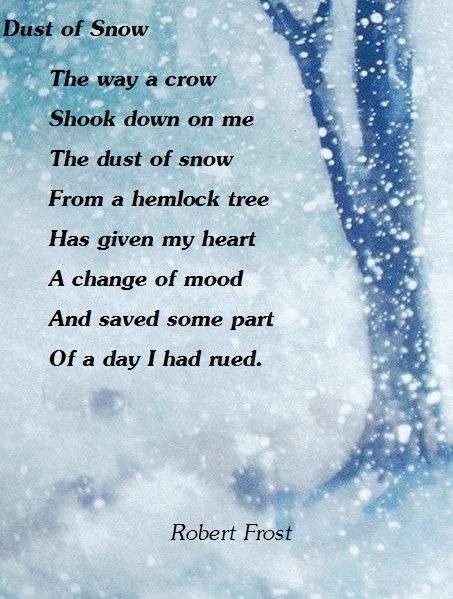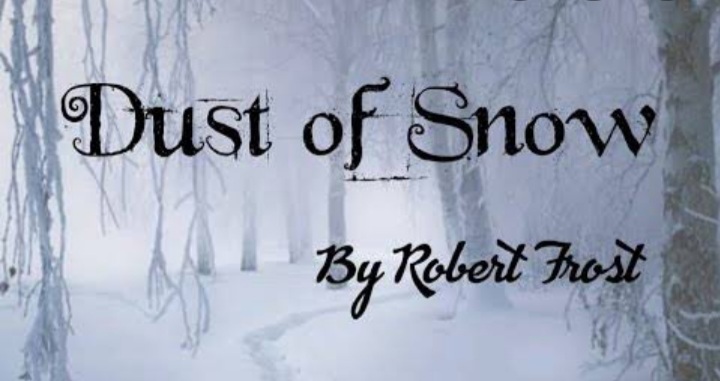About The Poet:Dust of Snow
- Robert Frost was born on 26th March 1874 in San Francisco. Robert Frost was influenced by the contemporary British Poets as Edward Thomas, Rupert Brooke and Robert Graves.
- He had published two full-length collections, A Boy’s Will in 1993 and North of Boston in 1914. He was the most celebrated poet from America.
- Poem- Dust of Snow is a fine poem of Robert Frost.

Poem: Dust of Snow
The way a crow
Shook down on me
The dust of snow
From a hemlock tree
Has given my heart
A change of mood
And saved some part
Of a day I had rued.
Introduction:
- The poem “Dust of Snow” is a short poem by Robert Frost. The sonnet comprises of two verses. This poem is set on winter’s day. The episode happens some place outside on winter’s day, as the artist was pondering.
- In the sonnet, the writer is remaining under a hemlock tree, there is a crow on the tree and the episode occurs.
- By the episode, the poet needs to let us know that the easily overlooked details in life can roll out colossal improvements in our future. It likewise shows that on the off chance that we can accept the difficult situations of life, in the end something will end up changing our circumstance into more joyful times.
Explanation: First Stanza
The way a crow
Shook down on me
The dust of snow
From a hemlock tree
Crow : Consider as bad omen
Hemlock: A poisonous plant (tree) with small white flowers.
- Robert Frost, in the poem, shows us one more side to the crow and the Hemlock tree. Crow is an image of a terrible sign and Hemlock tree is a noxious tree that is mean likewise terrible or most awful things yet the way in which the writer shows one more side of a crow and a Hemlock tree.
- The poet is remaining under a Hemlock tree and there is a crow on the tree. Unexpectedly, the crow dissipates some residue of snow on him.
- In this way, in the principal refrain the artist says how the residue of snow falls on him by the development of crow from the Hemlock tree.
Explanation: Second Stanza
Has given my heart
A change of mood
And saved some part
Of a day I had rued.
Rued: held in regret
- In the subsequent verse, the writer makes sense of that how such a basic occasion changes the mind-set of him.
- Dust of snow falls on the writer by some development of the crow from the Hemlock tree, this basic occasion provides his heart with a difference in state of mind by a hint of cold and delicate residue of snow and by that touch the writer feels revive and cheerful.
- Before this, his day was loaded up with laments. So the writer says such a straightforward occasion changes my temperament (mood) and recoveries remaining piece of the day from regret.
- Along these lines, a straightforward development ends up being exceptionally huge and saves the remainder of the day of the writer from being squandered and lament. The writer feels loose and appreciative to the nature for saving his day.
Message:
- The dust of snow implies the fine particles of snow which falls on the writer and changes his mind-set. The cold and delicate dash of snow changed the writer’s temperament (mind) from miserable to blissful.
- The message given by the writer through the sonnet “Residue of Snow” is a positive(cold and delicate hint of snow) change can happens through regrettable interaction (a crow consider as terrible sign, a Hemlock tree: noxious tree)also.
- The easily overlooked detail (cold and delicate hint of snow) can get large change life. Basic thoughtful gesture done can motivate others with excitement and may acquire gigantic transform them.
Poetic Devices:
- Rhyming words: crow-snow, me-tree, heart-part, and mood-rued.
- Rhyming Scheme: abab,cdcd.
- Alliteration : It is repetition a consonant sound at the start of two or more closely placed words. Example : the sound of “S” in “And saved some part.”
- Assonance: It is repetition of vowel sounds in same line. The repetition is at different places in different words. Example : the long sound of “O” in “Shook down on me,”
- Consonance: The repetition of consonant sound occurs in the closely connected words, Such a repetition of consonant sound occurs whether at first, middle or end of the words. Example: The consonant sound “D” is repeated in the line “Of a day I had rued.”
Activity: Thinking about the poem
- What do the ‘crow’ and ‘hemlock’ represent – joy or sorrow?
- What does the crow do to the poet?
- How was the poet’s day before that incident?
- What is “a hemlock tree”? Why doesn’t the poet write about more ‘beautiful’ tree such as a maple, or an oak, or a pine?
- Have there been times when you felt depressed or hopeless? Have experienced a similar moment that changed your mood that day?
- Suppose, you are at the place of the poet. What you will think about the incident that poet mentions in the poem? Supplement your answer with imaginative or real.
- Write your own poem by sharing such experienced or imagination of your own.
- Read the poem and enjoy with regard to poetic devices: Alliteration, Assonance and Consonance.
You may also learn about the poem:Fire and Ice by Robert Frost








Hi there, You’ve done an incredible job. I’ll definitely digg it and personally recommend to my friends. I’m sure they’ll be benefited from this site.
[…] Dust of Snow by Robert Frost […]